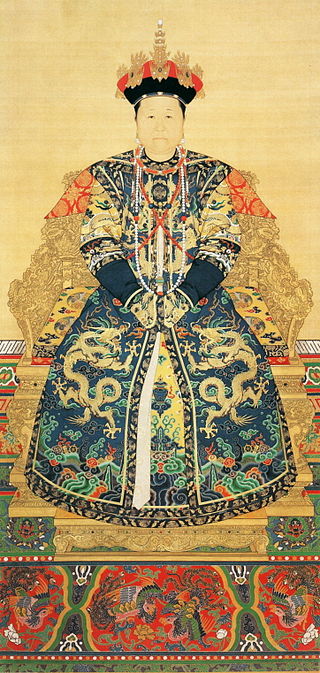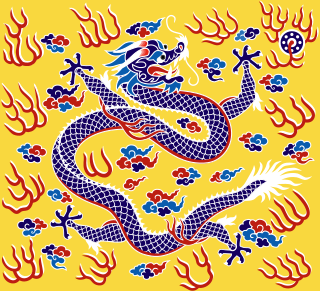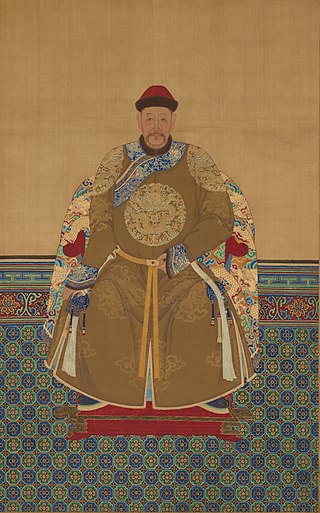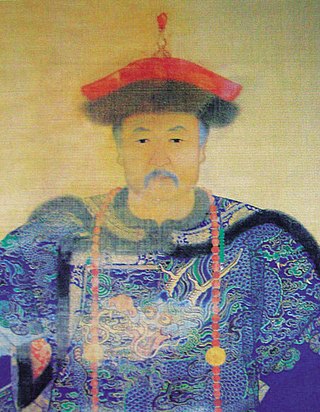
Dorgon, was a Manchu prince and regent of the early Qing dynasty. Born in the House of Aisin-Gioro as the 14th son of Nurhaci, Dorgon started his career in military campaigns against the Mongols, the Koreans, and the Ming dynasty during the reign of Hong Taiji who succeeded their father.

The Shunzhi Emperor was the second emperor of the Qing dynasty of China, and the first Qing emperor to rule over China proper, reigning from 1644 to 1661. A committee of Manchu princes chose him to succeed his father, Hong Taiji (1592–1643), in September 1643, when he was five years old. The princes also appointed two co-regents: Dorgon (1612–1650), the 14th son of the Qing dynasty's founder Nurhaci (1559–1626), and Jirgalang (1599–1655), one of Nurhaci's nephews, both of whom were members of the Qing imperial clan.

Hong Taiji, also rendered as Huang Taiji and sometimes referred to as Abahai in Western literature, also known by his temple name as the Emperor Taizong of Qing, was the second khan of the Later Jin dynasty and the founding emperor of the Qing dynasty. He was responsible for consolidating the empire that his father Nurhaci had founded and laid the groundwork for the conquest of the Ming dynasty, although he died before this was accomplished. He was also responsible for changing the name of the Jurchen ethnicity to "Manchu" in 1635, and changing the name of his dynasty from "Great Jin" to "Great Qing" in 1636. Hong Taiji could have been a Manchu of Mongolian origin, being the son of Yehe Nara Monggo Jerjer, or genetically related to the Mongols as a member of the Aisin-Gioro clan.

Bumbutai, of the Khorchin Mongol Borjigit clan, was the consort of Hong Taiji. She was 21 years his junior. She was honoured as Empress Dowager Zhaosheng during the reign of her son, Fulin, the Shunzhi Emperor, and as Grand Empress Dowager Zhaosheng during the reign of her grandson, Xuanye, the Kangxi Emperor.
Soni (1601–1667), also known as Sonin, and rarely Sony, was a Manchu noble of the Hešeri clan who served as one of the Four Regents of the Kangxi Emperor during the Qing dynasty (1644–1912). His clan belonged to the Plain Yellow Banner.
Suksaha was a Manchu official of the early Qing dynasty from the Nara clan. A military officer who participated in the Manchu conquest of China, Suksaha became one of the Four Regents during the early reign of the Kangxi Emperor in the Qing dynasty (1644–1912). He eventually fell out with another regent, Oboi, and was sentenced to death.

Ebilun was a Manchu noble and warrior of the Niohuru clan, most famous for being one of the Four Regents assisting the young Kangxi Emperor from 1661 to 1667, during the early Qing dynasty (1644–1912). A largely passive figure during the regency, Ebilun was disgraced following the ouster of the far more powerful regent Oboi and considered a political supporter of the latter. He was stripped of his positions by the emperor but later regained his noble rank. Many of his descendants became influential figures in the Qing imperial government.

The Plain Yellow Banner was one of the Eight Banners of Manchu military and society during the Later Jin and Qing dynasty of China. The Plain Yellow Banner was one of three "upper" banner armies under the direct command of the emperor himself, and one of the four "right wing" banners. The Plain Yellow Banner was the original banner commanded personally by Nurhaci. The Plain Yellow Banner and the Bordered Yellow Banner were split from each other in 1615, when the troops of the original four banner armies were divided into eight by adding a bordered variant to each banner's design. After Nurhaci's death, his son Hong Taiji became khan, and took control of both yellow banners. Later, the Shunzhi Emperor took over the Plain White Banner after the death of his regent, Dorgon, to whom it previously belonged. From that point forward, the emperor directly controlled three "upper" banners, as opposed to the other five "lower" banners.

Daišan was an influential Manchu prince and statesman of the Qing dynasty.
Jirgalang or Jirhalang was a Manchu noble, regent, and political and military leader of the early Qing dynasty. Born in the Aisin Gioro clan, he was the sixth son of Šurhaci, a younger brother of Nurhaci, the founder of the Qing dynasty. From 1638 to 1643, he took part in many military campaigns that helped destroy the Ming dynasty. After the death of Huangtaiji in September 1643, Jirgalang became one of the young Shunzhi Emperor's two co-regents, but he soon yielded most political power to co-regent Dorgon in October 1644. Dorgon eventually purged him of his regent title in 1647. After Dorgon died in 1650, Jirgalang led an effort to clean the government of Dorgon's supporters. Jirgalang was one of ten "princes of the first rank" (和碩親王) whose descendants were made "iron-cap" princes (鐵帽子王), who had the right to transmit their princely titles to their direct male descendants perpetually.
This is a chronicle of important events that took place under the Shunzhi Emperor of the Qing dynasty (1644–1912). It spans from the death of his predecessor Hong Taiji in September 1643, to the emperor's own death on 5 February 1661, seven days into the eighteenth year of the Shunzhi reign period. These dates do not correspond perfectly with the Shunzhi era itself, which started on 8 February 1644—on New Year's Day of the lunisolar year following the emperor's accession—and ended on 17 February 1662, more than one solar year after the emperor's death. The posthumous events related to the Shunzhi Emperor's burial and posthumous cult are also included.
The Four Regents of the Kangxi Emperor were nominated by the Shunzhi Emperor to oversee the government of the Qing dynasty during the early reign of the Kangxi Emperor before he came of age. The four were Sonin, Ebilun, Suksaha, and Oboi.
The Deliberative Council of Princes and Ministers, also known as the Council of Princes and High Officials and Assembly of Princes and High Officials, or simply as the Deliberative Council, was an advisory body for the emperors of the early Qing dynasty (1644–1912). Derived from informal deliberative groups created by Nurhaci (1559–1626) in the 1610s and early 1620s, the Council was formally established by his son and successor Hong Taiji (1592–1643) in 1626 and expanded in 1637. Staffed mainly by Manchu dignitaries, this aristocratic institution served as the chief source of advice on military matters for Hong Taiji and the Shunzhi and Kangxi emperors. It was particularly powerful during the regencies of Dorgon (1643–1650) and Oboi (1661–1669), who used it to enhance their personal influence.
The history of the Qing dynasty began with the proclamation of the Qing dynasty by the Manchu chieftain Hong Taiji in 1636, but the year 1644 is generally considered the start of the dynasty's rule in China. The dynasty lasted until 1912, when Puyi abdicated the throne in response to the 1911 Revolution. The final imperial dynasty of China, the Qing dynasty reached heights of power unlike any of the Chinese dynasties which preceded it, engaging in large-scale territorial expansion which ended with embarrassing defeat and humiliation to the foreign powers whom they believe to be inferior to them. The Qing dynasty's inability to successfully counter Western and Japanese imperialism ultimately led to its downfall, and the instability which emerged in China during the final years of the dynasty ultimately paved the way for the Warlord Era.

The Later Jin, officially known as Jin or the Great Jin, was a Jurchen-led royal dynasty of China in Manchuria and the precursor to the Qing dynasty. Established in 1616 by the Jianzhou Jurchen chieftain Nurhaci upon his reunification of the Jurchen tribes, its name was derived from the earlier Jin dynasty founded by the Wanyan clan which had ruled northern China in the 12th and 13th centuries.

Fan Wencheng was a Qing dynasty scholar-official, Prime Minister and Grand Secretary (Daxue Shi). His official career went through four generation of Qing dynasty emperors through Nurhaci, Hong Taiji, Shunzhi, and Kangxi. Many rules and regulations in the early days of the Qing dynasty were drafted by him.
Events from the year 1661 in the Qing dynasty.
Events from the year 1667 in China.
Aisin Gioro Jidu was Qing dynasty imperial prince as the second son of Jirgalang, Nurhaci's nephew. Jidu was the second holder of Prince Zheng title under the name "Prince Jian of the First Rank". The previous name was restored only in 1778.









